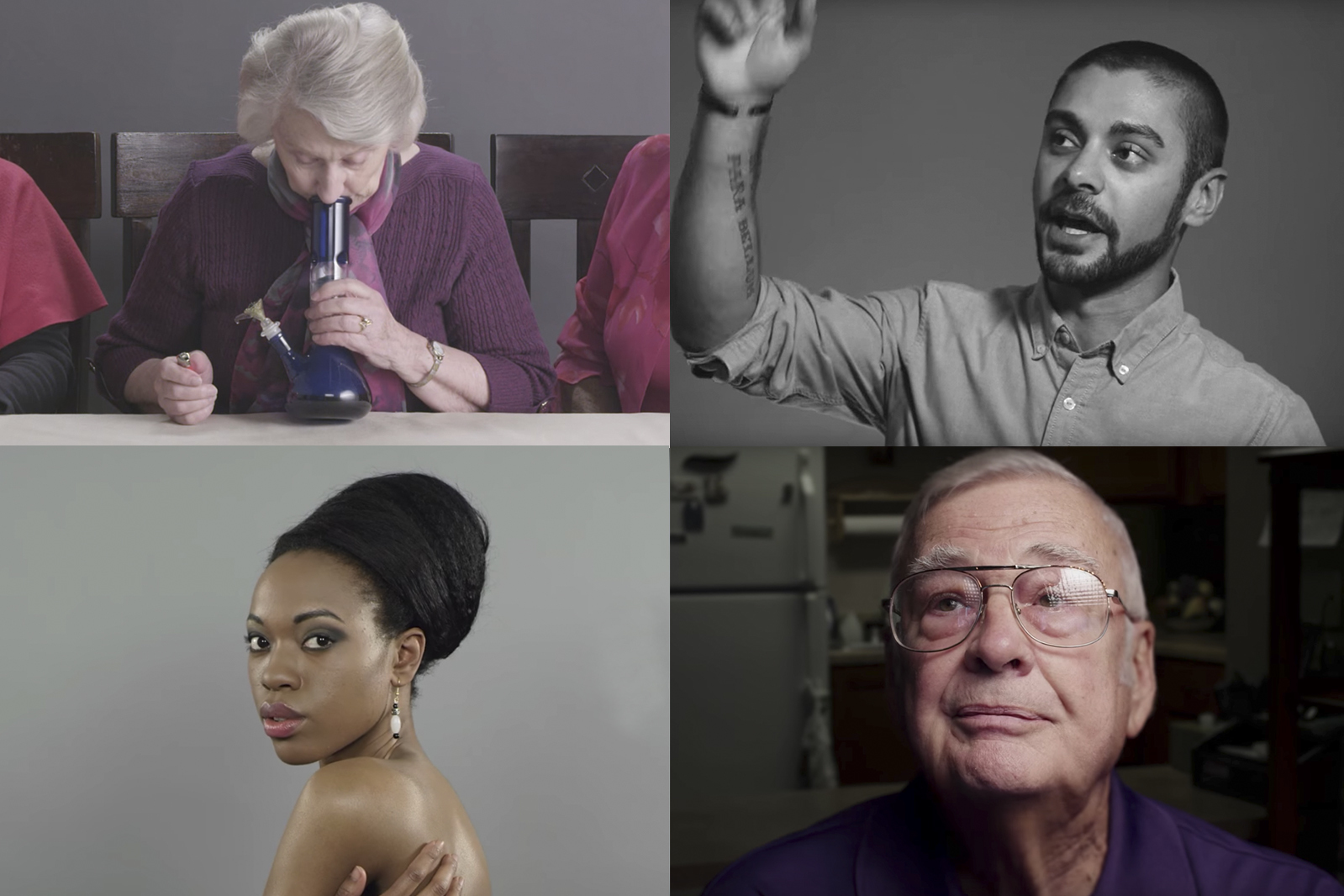Paula had never heard the word “viral”—at least not in this context.
She’d just taken part in what was for her an unusual project. It was the fall of 2014, and she had been invited to a studio in Seattle where she sat alongside two other women who, like her, were in the later years of their long lives. They also, like her, had never smoked marijuana, despite its legality. Within an hour of her arrival, that changed. As a crew from local video production company Cut looked on, the three women took rips from a bong, then proceeded to play party games—Jenga and Cards Against Humanity—smoke a little more from a vaporizer, and laugh. All the while the cameras rolled. In less than an hour, it was over.
Despite the event’s casual nature, the production team seemed happy. Blaine Ludy—a Cut co-founder and the producer on this shoot—approached Paula, beaming.
“He told me it was great,” she recently recalled. “He said he thought it might go viral. I had no idea what that even meant.”
Soon she would.
A month after the shoot, Paula received a call from her son, who, as an employee of the Seattle-area agency contracted by Cut to find talent, had drafted her for the project. “He told me that it went viral,” Paula said. “He asked me if anyone had recognized me. Then I started to get paranoid.”
The video, titled “Grandmas Smoking Weed for the First Time,” had by that point been viewed by 3.5 million people and picked up by every media outlet in search of clicks. It had indeed gone viral. And, yes, people would start to recognize Paula.
“The first time was when I was at the dollar store buying a candle holder,” Paula said. “The young man at the check-out said, ‘Oh my God. You’re the woman from that video.’ He was shaking. And I was just like, honey, I’m not Kim Kardashian.”
Paula wasn’t the only one whose world was changed by the six-minute video of grandmas getting stoned. When the video posted, the people behind the camera were in need of a hit. Cut was being kept afloat by parent company Stripes39, a Seattle-based start-up studio. For months the production company’s three founders had been trying to find exactly what it was that they do. They explored building a company aimed at maker girls, but decided that that was no place for a company run by three men. Then they toyed with the idea of crowd-sourcing big-budget films, until their lawyers informed them that that plan was illegal.
Creative director and co-founder Mike Gaston had another idea: short-form videos that pack an emotional punch. But the bosses at Stripes39, who had already invested $250,000 in the team, were getting impatient and encouraged them to copy someone else’s great idea. They advised the team to build a vertical—or website—like wildly popular viral sites Buzzfeed and Upworthy, which both produce and host content.
Then came Paula’s pot party.
“When I saw ‘Grandmas Smoking Weed,’ I knew they had it,” says Salil Jain, one of Stripes39’s seven founders. On the heels of the that success, Stripes39 invested another $750,000 in the fledgling production company.
A year and a half later, “Grandmas Smoking Weed” is at 26.5 million views and Cut is at the leading edge of an emergent media sector. While Seattle has a small industry of high-quality for-hire video production houses that includes stalwarts Digital Kitchen and World Famous, Cut is doing something different by continuing to pump out a lot of original content while offering its services to other companies.
There is reason to believe the model is working. In the past year, the founders have seen competitors mimic their blend of unerring viral appeal with a humanistic ethos. The company has also shied away from at least one potential buy-out offer from a major media outlet and, early this year, completed a successful round of investment. In addition to capital investment of an undisclosed sum, Cut was also added to the roster of Gunpowder & Sky, a big-shot L.A. digital studio with the connections and know-how that will pair Cut with paying partners while helping its own videos reach a global audience.
All this has happened as the company has remained anchored in Seattle, having just moved into a large studio in Lower Queen Anne. There, far away from the media centers of Los Angeles and New York, it is attempting to turn its short videos about real people into a sustainable business.
Gaston is giving himself until the end of 2017 to make that a reality, but between now and then challenges abound—not the least of which are keeping the quality high, the costs low, and the audience growing.
When Mike Gaston was first hired as a freelancer at Stripes39, then an Internet marketing firm, he was resistant to the idea of viral content—in particular the belief that one could make something viral. “They were all about virality and I was super-snobbish against that,” Gaston says now. “I remember saying when I came in, ‘What does that even mean? The next person that says ‘predictive virality’ to me, I’m going to punch in the face. That’s bullshit. How can you make anything viral? They are an outlier for a reason.’ ”
It made sense that Gaston would be cool to the idea that a mere formula could help a story find an audience. To Gaston, who only a few years before had graduated with a bachelor’s in English lit from the University of Washington, the mechanism of great content was an elusive cocktail of individual genius and chance, not some soulless rubric that could be applied by any would-be producer with the attention span to read Chip and Dan Heath’s 2007 book, Made to Stick: Why Some Ideas Survive and Others Die.
This idea was perhaps bolstered by Gaston’s first success in video production back in 2007. While working a job in contract negotiations and supply-chain management at Boeing to support his wife’s graduate studies, he got a wild hair to make a video for his friends in the indie-rock act Minus the Bear.
Gaston had never made a video before, and his inexperience shows. The video, for the song “Throwin’ Shapes,” is clearly the work of an amateur—the tale of two star-crossed, hyper-competitive lovers is filmed on the streets of Seattle using lots of slow motion and soft focus—but it told a story, and featured some original humor and a lot of heart. Minus the Bear’s record label, Suicide Squeeze, liked it enough to buy the video for $5,000, and MTV placed it in rotation.
With a little cash and some confidence, Gaston quit his job and dove into video production. He spent the next 18 months learning the craft, scouring Craigslist for jobs—many of them unpaid—where he could test new skills. When his savings ran out, he took a job with CBS Radio, where he worked as a video production manager for The Bob Rivers Show. After a year and a half in the radio trenches, he quit to form what he calls a “digital humanities nonprofit” with some like-minded friends.
Called Rogue Scholar, the nonprofit allowed him to flex his creative muscle while creating content that spoke to his passion for social justice. But grants were not easy to come by, and the organization’s bigger projects—an interactive piece exploring the gentrification of Yesler Terrace, a documentary on the first novel written by a Filipino-American—never materialized. When his savings dried up again, Gaston landed at the doorstep of Stripes39 with a bit of a chip on his shoulder and a charge to create video that would help market the commerce websites that were then Stripes39’s primary concern.
As he began to get results, Gaston’s misgivings about viral content slowly faded. “I was excited about the fact that here was a place where the things I was making were actually being seen by people,” he says. “And over the course of time I realized that there were things that could make something go viral, that you can set conditions that give something the best opportunity to be seen by people.”
Stripes39 was growing rapidly, but its founders were uninspired by the work they were doing. In 2012 they decided to change course. Stripes39 shut down the commerce websites, slimmed staff numbers, and transformed into a start-up studio. Gaston, Ludy, and Jason Hakala signed on as one of the firm’s first start-ups. Under the moniker Superfrog Saves Tokyo—named after a short story by Haruki Murakami—the trio started a creative agency and proceeded to do pretty much the same thing they were doing before: creating viral content for niche websites offering insurance quotes or medical-billing certificate training.
They were having some success, but not much fun. Then one of the Stripes39 bosses had a request: He was getting married, and he wanted a video of the ceremony to go viral. “I said, ‘Why, why do you want that? It’s terrible,’ ” Gaston recalls. “ ‘But OK, fine, let me try to help you.’ So what we did is we made a slow-motion wedding booth for him.”
The SFST team edited the footage and added a soundtrack of “Bran New Thang” by Seattle hip-hop outfit the Physics. Just as the partner asked, it went viral. The video was picked up by numerous media outlets, and within a week more than 1,000 requests came in for the same thing, including inquiries from Martha Stewart and Snoop Dogg.
Quang + Ellie: Slow Motion Booth from Super Frog Saves Tokyo on Vimeo.
But Gaston didn’t want to get into the wedding business, so he and his team made another short: “How to Do a Slow-Motion Booth on a Budget.” They posted that segment to Vimeo, pretty much birthing a new genre of online video, and moved on. But not until their Stripes39 advisors weighed in and insisted that they stop wasting their talents on boring commerce sites.
“We told them we invested in them to be a video-content think tank,” Jain says. “We wanted them to explore emergent business models and see what was interesting and go after it.”
And with that, Superfrog Save Tokyo was shelved and Cut was born.
It is the Friday before the Fourth of July weekend, and eight members of Cut’s 19-person staff are gathered in the company’s large conference room. The overhead lights are off and the only light comes from an internal window to the open floor plan below and the eight Macbooks, all open in front of the team members. This is an ideation session, or what Gaston—who tries to eschew the nomenclature of startup culture—would prefer to call a brainstorming session. A new script is being discussed.
“I know you guys are working with a lot of problems,” he says, setting the parameters for the conversation. “The problems being that this is supposed to be an election explainer series that is under 2 minutes. I like the lens that we are looking at this through—which is, ‘Everything is about kids, so we’re using kids to do it’—but we also have limited budget, I get it.”
Since “Grandmas Smoking Weed” put Cut on the map, the company has expanded its services. Throughout 2015, the company made zero money, Gaston told me in an earlier interview. That year, he said, was aimed at proving that it could replicate the success of the “Grandmas” video—that the team could indeed produce predictive virality. It did, launching a number of different video series—or formats, as the Cut producers call them—that include titles like “100 Years of Beauty,” “On Killing,” “Truth or Drink,” and “One Word,” and racking up 290 million views on 203 YouTube videos and 117 million views on 190 Facebook videos.
This year, says Gaston, the team must prove that Cut can actually make money, which of course is key to its survival. And so Cut is now churning out two other types of content in addition to its traditional editorial product: UnCut, through which the company provides white-label video production services to companies for a fee; and Cut Originals, which are videos produced with and licensed by other platforms or media entities. According to production manager Sarah Shipley, 50 percent of Cut’s efforts are currently being put toward editorial products, which do bring in some ad money but are more important as a vehicle to maintain Cut’s profile and develop new formats. Another 20 percent goes toward UnCut and the remaining 30 percent toward Cut Originals—projects like the one the team is talking about right now.
In just one week these scripts are due for approval to the media partner, a popular liberal news site. The staff acknowledges the political slant of the partner in this effort, yet Gaston is insistent that they not play into ideological tropes.
“I don’t want to be prescriptive in our work,” he says. “I don’t want people to watch this and be lke, ‘Oh, okay, yeah, we need to vote for Hillary Clinton, obviously.’ Or ‘Donald Trump is evil.’ What I want to do is be like, Well, let’s look at this like adults even though we’re using children. That’s the humor in it. We’re using kids to show you how the dialogue is not very mature.”
There is a suggestion that the kids be scripted, which is shot down immediately by Gaston. “I’d rather not be exploitative or corny,” he says. “If we have the kids talk, it should be them naturally responding to our questions.”
This is the second time he has brought up this point. Clearly, getting the kids right is key to getting the right response.
“This is not going to be good if there is no emotional catharsis,” he says before wrapping up this portion of the meeting. “I want people to be either really delighted by it or get really angry. But not be able to tell what our opinion is about it. We’re the jesters.”
And with that, the rest of the staff is invited into the conference room to join in a critique of some recent videos.
First up is one titled “On Memory.” It has the unmistakable trappings of a Cut production. The camera jumps between six subjects, each filmed individually against a simple shadowy backdrop, lit tastefully, and accompanied by an understated classical score that stitches together the four-minute montage. A title card informs the views that each of these subjects has been diagnosed with Alzheimer’s and they are here to answer a few questions: What is your first memory? What is your last memory? Can you remember your first kiss? The video is a quiet emotional rollercoaster, sometimes funny and endearing and in a few instances truly heartbreaking. It has garnered 140,000 page views since its June 14 launch. It’s not a smashing success, but everyone in the room is a big fan. In lieu of any real criticism, Ludy, who produced the piece, walks the group through his process.
“I was getting pretty morbid with it,” he says. “All these people know this disease is going to kill them. I think by the end I was trying to embrace that too much. But that’s the easier approach and I knew that what Cut would do differently is find the joyful moments.”
Next up is the latest in Cuts’ most successful format, “100 Years of Beauty.” The concept is, like most things at Cut, simple: make over one model 10 times in just over a minute, each look representing an ideal of beauty in a different decade, starting in the 1920s. The first “100 Years of Beauty”—which focused on American ideas—was conceived at the same time as “Grandmas Smoking Weed” and released soon after. It has earned 28 million views since and has been replicated 20 times using a world of nationalities. The latest, which is being cued up by Chris Chan, who oversees the research and execution of the entire series, is for Kenya. On first blush, it seems to have all the makings of a Cut hit.
But Chan isn’t happy. “I’m having two feelings about 100 Years of Beauty,” he says. “One is that it’s feeling procedural. The other problem is an old one, which is how to represent a place with many different tribes or ethnic groups in just 10 looks.”
As a counterpoint he cues up a new episode, this one representing Puerto Rico. Over a split screen we see two Puerto Rican identities—one from the homeland and one in New York—transform in front of vibrant backdrops of blue and red. The music is pulsating, the model more engaged. It’s a clear evolution for the format and by the end, the room is charged. But there is also a sense of unease.
“I love it,” says Chan. “But it’s so delightful to watch that I worry about the future videos. I feel like we made an aesthetic intervention this time, but now all of them need to make a new aesthetic intervention.”
The next video, the latest episode of the “On Killing” series, is also something of an intervention. Whereas most of Cuts’ videos are clearly shot in studio, this video was shot on location. In it, an older man, recently released from prison after serving time for a triple homicide, sits in his derelict home in some wintry rural countryside telling how he did it. The shocking details of a robbery gone wrong are interspersed with stunning shots of the landscape, sometimes featuring the subject walking along in slow motion. The video earned a Staff Pick from the video platform Vimeo. “I love this channel,” one commenter posts below the video. “It’s like Buzzfeed but with a point.”
Nonetheless, Gaston hates it. “Do you know why this was a Vimeo Staff Pick?” he says with an edge of irritation in his voice. “Because it uses slow motion.” The numbers agree with Gaston; the video has earned only 36,000 views since being posted in March.
To contrast, Gaston aims the browser to YouTube to play an earlier video in the “On Killing” series. The image that appears could not be more different from the previous clip. Shown in black and white is a young man named Josh set against a blank backdrop. He is an Iraq War vet. Unlike the murderer’s hazy tale, this story is delivered with vivid clarity, the veteran excited to take credit for the lives he ended.
“My first kill was this guy,” he says. “I just watched him running from a tree to a larger rock outcropping right in front of us … I aimed my grenade launcher at him and fired and just watched my round go in and just nail him right at his feet. Just guts. Pretty rad.”
The video is not artfully crafted to obscure or romanticize the realities of killing in wartime; it does not apologize for the actions of its subject, in the way that the previous clip reached for some personal or aesthetic resolution. Josh’s words hang in the air over the heads of the staff.
Gaston says he aims to keep his videos apolitical, and yet the company does not shy away from the most pressing subjects of the moment. What Gaston finds so interesting about a clip like this—and, he argues, one of the qualities that makes a clip like this so resonant—is not what it says about the political, but what it says about the personal.
“I’m really interested in the continuity-of-identity paradox,” Gaston told me earlier, “this question of, Am I the same person I am today as I was 10 years ago? If I start replacing body parts with robot parts, at what point do I stop being me and start being something else?”
If you give grandmas weed, will they still be sweet old ladies? When you take away someone’s memory, do they cease to be who they were? When a person kills another human being, does his own humanity diminish?
Cut doesn’t attempt to answer these questions; that is up to the viewer. But that doesn’t mean that Gaston is attempting to spread ambivalence, either. In seeking universal subject matter and actually showing the kinds of transformations that are inherent in all walks of humanity, he says, Cut seeks to build some kind of understanding.
“Something like grandmas smoking weed is not about being activisty,” he said. “It’s not about saying that we need to allow people to smoke weed—I don’t smoke weed. It’s about looking at something that is complicated and not simplifying it; just making people feel comfortable with the complication.”
Fortunately for Cut and its investors, this simple delivery of the complexities of life also makes for some pretty compelling content. And because Gaston, Ludy, and Hakala possess the tools to get that content in front of more eyeballs, there is a chance that this Seattle company could create a permanent place for thoughtful storytelling that everyone can share.
“People are always looking down at their screens and you get fed the things that you are looking at algorithmically,” he told me. “It allows people to be in these sort of bubbles, and something that goes viral … it has the opportunity to puncture those bubbles.”
mbaumgarten@seattleweekly.com








